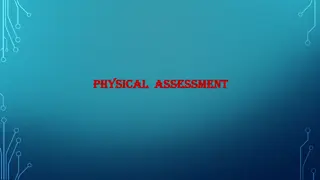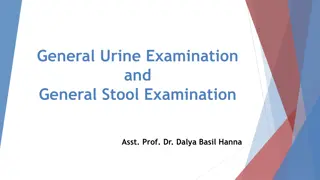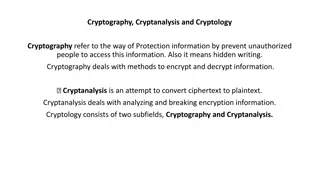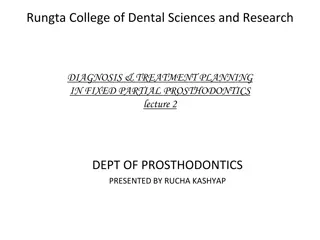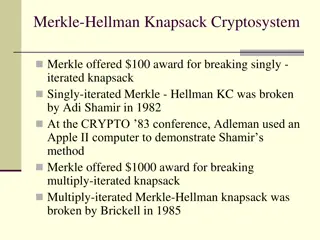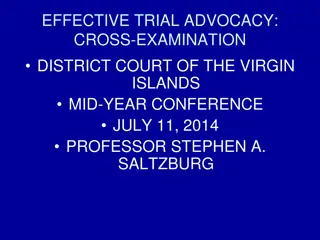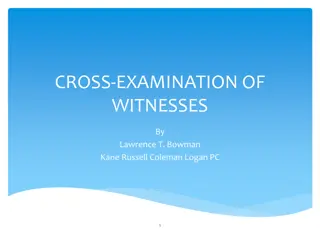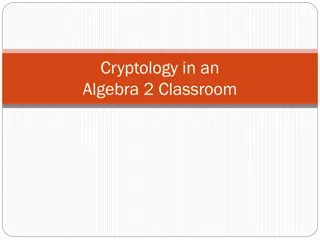Cryptology System Design Fundamentals: ARSA Cryptosystem Examination Solutions
The given content discusses the solution to an ARSA cryptosystem final examination design problem, involving the computation of public and secret keys for users A and B, encryption and signing of messages, and considerations for attacker interceptions and computations. The solution guides through the steps for determining keys, encrypting messages, generating signatures, and analyzing attack vulnerabilities. It covers the process of decryption, signature verification, and attacker computation possibilities based on the provided parameters and calculations.
Download Presentation

Please find below an Image/Link to download the presentation.
The content on the website is provided AS IS for your information and personal use only. It may not be sold, licensed, or shared on other websites without obtaining consent from the author.If you encounter any issues during the download, it is possible that the publisher has removed the file from their server.
You are allowed to download the files provided on this website for personal or commercial use, subject to the condition that they are used lawfully. All files are the property of their respective owners.
The content on the website is provided AS IS for your information and personal use only. It may not be sold, licensed, or shared on other websites without obtaining consent from the author.
E N D
Presentation Transcript
Cryptology System Design Fundamentals Grundlagen des kryptographischen Systementwurfs Module ID: ET-IDA-057, ET-IDA-110 Final Examination Design-Problems Section: Open book examination part V14-A 31.05.2023 Prof. W. Adi Date : Duration : 120 Minutes. 70% of the evaluation score 16.03.2018 Please write your answer on the same question sheet. Bitte schreiben Sie die L sungen auf die Aufgabenbl tter. Vorname .. Nachname .. Matrikel-Nr. . 06.04.2021 - v12 Page 1 Fachrichtung:
Max 70% marks Marks: Problem 1 Problem 2 Problem 3 Problem 4 Problem 5 Problem 6 Total Page 2
(25 P) P1: ARSA cryptosystem with two users A and B having the following secret prime number pairs: for user A: 11 and 23 and for user B: 13 and 17 1. Find out the adequate public key of user A from the following list of integers: [15, 87, 112] giving the reason for your choice. Compute the corresponding secret key of user A. 2. Find out the adequate public key of user B from the following list of integers: [55,120,159] giving the reason for your choice. Compute the corresponding secret key of user B. 3. How many distinct public keys are possible for each user? 4. User B encrypts the message M=19, and send the resulting cryptogram YBAto A. User B then signs h= ( M2) mod NAand generates the signature SBA. Compute YBAand SBA. 5. For which range of the values of M can an attacker compute M by observing SBA? Why? 6. Decipher the cryptogram YBAon user A s site and verify the Signature SBA. Page 3
Solution: 1. Find out the adequate public key of user A from the following list of integers: [15, 87, 112] giving the reason for your choice. Compute the corresponding secret key of userA. NA = 11 x 23 = 253, (NA ) = (11-1)(23-1) = 220 gcd [ EA, (NA ) ] = 1 => select 87 as gcd (87,220) = 1 EA = 87 DA = 43 mod 220 = (see computation below) 3 DA= 87 -1 mod 220 =43 u a1 a2 220 87 1 0 87 46 0 1 46 41 1 -1 41 5 -1 2 5 1 2 -17 GCD m b1 0 1 -2 3 -5 b2 1 -2 3 -5 43 q 2 46 1 41 1 8 5 r INVERSE VALUE 1 5 1 0 INVERSE= 43 GCD= 2.Find out the adequate public key of user B from the following list of integers: [55,120,159] giving the reason for your choice. Compute the corresponding secret key of user B. 3 NB = 13 x 17 =221 , (NB) = (13-1)(17-1) = 192 gcd (EB, (NB ) ] =1 => select 3 as gcd (55,192) = 1 EB = 55 DB = 7 mod 192 (see computation below) DB= 55 -1 mod 192 = 7 m u a1 192 55 1 55 27 0 27 1 1 GCD a2 0 1 -2 b1 0 1 -3 b2 1 -3 7 q 3 2 27 r INVERSE VALUE 27 1 0 7 1 INVERSE= GCD= 3. How many public keys are possible for each user? 4 # of keys for user A = [ (NA )] = (220 ) = (22 . 5. 11)= 220(1 -1/2 ).(1 1/5).(1 1/11) = 80 keys # of keys for user B = [ (NB )] = (192 ) == (26 . 3)= 192(1 -1/2 ) (1 -1/3 ) = 64 keys Page 4
4. User B encrypts the message M=19, and send the resulting cryptogram YBAto A. User B then signs h= ( M2)mod NAand generates the signature SBA. Compute YBAand SBA. Can an attacker get M by observing SBA. if yes how? If No, why? Encryption: YBA =(M)Ea mod Na = (19)87 mod 253=178 Sings: H(M) = h = (M2 mod NA) = 192 mod 253 = 108 SBA =(h)Db mod Nb = (108)7 mod 221=82 6 5 5. For which range of values of M can an attacker compute M by observing SBA? Why? Computing M is passable if M2< NA in that case the square root is computable. As the modulus NAwould deliver the real M2and computing the square root is straight forward as the modulus is not involved. If however, the modulus is involved, then computing the square root mod NAis only possible if the factorization of NAis known. 6. Decipher the cryptogram YBAon userA s site and verify the Signature SBA Decipher: M= (YBA )Da mod Na = (178)43 mod 253=19 Verification if M is signed by B:: h = (SBA )Eb mod Nb = (82)55 mod 221=108 Check if h=108 = M2 mod Na = 192 mod 253 = 108 is true. Therefore, Signature of B is authentic.. 4 Page 5
(28 P) P2: DH over GF(25) A Diffie-Hellman (DH) public key exchange system uses GF(25) deploying the primitive Polynomial P(x) = x5+ x2+ 1 as field modulus. 1. Compute the exponents of the element x = 000010 as ximod P(x) for i= 1 to 10in binary form in GF(25). 2. Which multiplicative orders are possible for elements in GF(25)? Why? Compute the multiplicative order of the element = x15and its binary vector. 3. Use the element as a public element and compute the DH public keys Yaand Ybas binary vectors for users A and B having the secret keys Xa=13 und Xb=19. 4. Compute the polynomial and binary pattern for the shred key ZABof users A and B . 5. Setup the ElGamal cryptosystem and compute the cryptogram CAas a binary vector for the message M=x30 sent from A to B by using the same above DH setup and using a random R=11. 6. Decrypt CAon B s side showing all necessary computations. Page 6
Solution 1. Compute the exponents of the element x = 000010 as ximod P(x) for i= 1 to 10inbinary form in GF(25). P(x) = x5+ x2+ 1 = 0 => x5= x2+ 1 x1= x=00010 x2= x2=00100 x3= x3=01000 x4= x4=10000 x5= x2+1=00101 x6= x3+x=01010 x7= x4+x2=10100 x8= x5+x3= x3+ x2+1=01101 x9= x4+ x3+x=11010 x10= x5+ x4+ x2= x4+ x2+ x2+ 1= 10001 2. Which multiplicative orders are possible for elements in GF(25)? Why? Compute the multiplicative order of the element = x15and its binary vector. Possible orders are the divisors of 25-1 = 31 : that are: 1, 31. As x1 1 => Ord(x)=31 = ( ) ord i ( ) ord 31 As ??? = ??? x15= gcd[31,15]= 31 gcd[ ( ), ] ord i = x15= x10. x5=(x4+1)(x2+1)= x6+ x4+ x2+ 1= x3+ x + x4+ x2+ 1= x4 + x3+ x2+ x + 1 =11111 Page 7
3. Use the element as a public element and compute the DH public keys Yaand Ybas binary vectors for users A and B having the secret keys Xa=13 und Xb=19. User A: Xa= 13 , Ya = 13 =( x15) 13 =x 15.13 mod 31= x9 = x4+ x3+x User B: Xb= 19, Yb = 19 =(x15)19 = x 15.19 mod 31= x6 = x3+x Public directory GF(25) =x15, P(x) = x5+ x2+ 1 Ya= 11010 Yb= 01010 Ya= 11010 Yb= 01010 2 2 4. Compute the polynomial and binary pattern for the shred key ZAB of users A and B . 4 Common secret key for users A and B: Zab = ( (x15 )13) 19 = x 3705 mod 31 = x 16 = x10. x6 = ( x4+1 ).( x3+x)= x7+ x5+ x3+x= x4+x2+x2+1 + x3+x Zab = x4+x3 +x+1=11011 Page 8
5. Setup the ElGamal cryptosystem and compute the cryptogram CAas a binary vector for the message M=x30 sent from A to B by using the same above DH setup and using a random R=11. 6. Decrypt CAon B s side showing all necessary computations. User A sends M to B User B receives =x15primitive element in GF(25) ya= Xa= x9= 11010 yb= Xb= x6 = 01010 Xa =13 ya= Xa = x4+ x3+x Xb = 19 yb= Xb= x3+x C M=x30 C = M . Z = x30.x4 = x34mod (31), C=x3 M M X X M = C . Z-1 = x3. x27= x30 = M Z = Xb. R=(x15)19.11 mod 31=x4 Z-1 = x27 yb (yb)R r = R=(x15)11 mod 31=x10 Z-1= (r)-Xb= x10 *12 mod 31 = x27 R R As -Xb = -Xb mod(25-1) -Xb = Xb + (31) = -19 + 31= 12 R = 11 Page 9
P3: Compute the multiplicative inverse of x2 + 1 modulo P(x) = x7+ x6+ 1. (6P) Verify your result Solution P1(x) P2(x) B1(x) B2(x) Q(x) x5+x4+x3 +x2+x+1 x R(x) x7 + x6 + 1 x2 + 1 0 1 x x2 + 1 x 1 x5+x4+x3+x2+x+1 1 x 1 x5+x4+x3+x2+x+1 x6+x5+x4+x3+x2+x+1 x 0 Check: (x2 + 1 ) (x6+x5+x4+x3+x2+x+1) x7= x6+ 1 x8= x7+ x = x6+ x + 1 = x8+x7+x6+x5+x4+x3+x2 + x6+x5+x4+x3+x2+x+1 = x6+ x + 1 + x6+ 1 + x + 1 = 1 Page 10
P4: A block cipher having a key length of 194 bits is encrypting a clear text. Where, the clear text block size is 256 bits and the unicity distance of the cipher nu = 258 bits. 1. Compute the entropy of the clear text. 2. Compute the new unicity distance of the cipher if 64 random bits are appended to each clear text block. And the clear text is compressed to 50% of its original length. 3. Is the cipher theoretically breakable after this modification if the attacker can only observe 600 cipher text bits? Why? (9 P) Solution: 1. Entropy of a clear text Unicity distance nu= K/r K= 194 bits, nu =258 bits, N = 256 bits the redundancy is r = K / nu= 194/ 258 = 0,75 As r = [ N H(x) ] / N => H(X)=N N.r => H(x)=N(1-r) H(x)=N(r-1)=256(1-0.75) = 64 bits 256 bits block 2. New Unicity distance after compression 50% clear text compression results with a clear text entropy of 64 in each 128 bits block. Using the same cipher block size results with 192 bits compressed clear text data in each block + 64 bits random padding After 50% compression each 128 bits clear text include 64 entropy bits, therefore The clear text entropy in the 192 bits is 192 x 64/128 = 96 bits. Therefore the new redundancy is: r = 256-(96+64)/256 = 0,375. Therefore the new unicity distance is nu = K/r = 194/0,375 = 517,33 bits. 192 bits compressed clear text H(x)=96 bits 64 bit random padding 3. After modifications, the observer can theoretically gain the secret key as the number of the observed cryptogram bits (600 bits) is greater than the new Unicity distance of the ciphering process (517 bits). Page 11
(35 P) P5: El-Gamal crypto system is set up . A prime number P = 6 x 13 + 1 = 79 is used to generate GF(P), where q=13 is a prime. 1. 2. Prove that P is a prime according to Pocklington s theorem. Find computationally the multiplicative orders of the elements 2 and 3 in GF(79). Compute the probability, that a randomly chosen element is a primitive one. ElGamal signature scheme according to Fig .1 is used to sign M=6 in GF(79). The element = 3 is selected as a public group generator. Compute the signature S for M according to Fig.1. Assume Xa= 13 and select your own adequate K. Encrypt the message M using a simple secret-key multiplication cipher C(M) = Ks. M mod 79. Select Ks= 32. Compute the number of possible keys for this cipher. Decrypt C(M) Under which conditions is the cipher C(M) impossible to break ? Why? 3. 4. 5. 6. Page 12
public directory User A signs M Verifier is primitive in GF(P) ya= public key of A Xa= Secret Key of A p, , ya Xa= ya If MD M k-1( MD - r . Xa) mod (P-1) = S S = S MD = yar. r S mod P k= r k r Then M is authentic k Random unit in ZP-1 Signed Message Fig. 1 Page 13
Solution: 1. Prove that P is prime according to Pocklington s Theorem. P = R . F + 1 =6. 13 +1 = 79 , F =13 and R = 6. Is 79 a prime? Proof: 1. gcd ( a (P-1)/ pj 1 , P ) = gcd ( 6 138/ 23 1 , 79 ) = gcd ( 63 , 139 ) = 1 is true 2. a P-1= 1 ( mod P ) 678= 1 (mod 79) is true 3. F > 79 = 8,xx that is 23 > 8,xx is true As all conditions 1, 2 and 3 are all true 79 is a prime number. 2. Find computationally the multiplicative orders of the elements 2 and 3 in GF(79). Compute the probability, that a randomly chosen element is a primitive one. Possible multiplicative orders are the divisors of of (79) = 78 that is => 1, 2,3,6,13,26,39, 78 Checking if the element 2 is a primitive one: 2 1 1 , 2 2 1 ,2 3 1, 2 6 1, 213=55 1, 226=26 1, 239=1, Ord (2) = 39 2 is not a primitive element. Checking if the element 3 is a primitive one: 31 1 , 32 1 ,33 1, 36=18 1, 313=24 1, 326=23 1, 339=78 1, Ord (3) = 78 3 is a primitive element the probability that a randomly selected element is primitive. # of all non-zero elements : 79 1 = 78 # of primitive elements: ( 78) = ( 2.3.13) = (2-1)(3-1)(13-1) = 24 P( element=primitive ) = ( 24 / 78 ) . 100 = 30,77% Page 14
3. ElGamal signature scheme according to Fig .1 is used to sign the message M=6 using GF(79). The element = 3 is selected as a public group generator. Compute the multiplicative order of and the Signature PS for M according to Fig.1. Assume Xa= 13 and select your own adequate K. User A signs M=6 GCD m m 78 5 3 2 u u 5 3 2 1 a1 a1 1 0 1 -15 a2 a2 0 1 -1 2 b1 b1 0 1 -15 16 b2 b2 1 -15 16 -31 q q 15 1 1 2 r r 3 2 1 0 INVERSE VALUE = B2 Xa= ya= 313mod 79 = 24 Select k=5 => r = k= 3 5mod 79 = 6 Calculate k-1in ZP-1 = 5-1mod (P-1) k-1= -31 mod 78 =-31+78 = 47 INVERSE= -31 GCD= Signature S = k-1( M - r . Xa) mod (P-1) = 47 (6 - 6.13) mod 78 = 47( 6 - 0) mod 78 = 48 4. Encrypt the message M using a simple secret-key multiplication cipher C(M) = Ks . M mod 79. Select Ks = 32. Compute the number of possible keys for this cipher. C(M) = KS . M mod 79 = 32 x 6 mod 79 = 34 It is the number of invertible integers modulo 79, # possible keys for KS = (79) = 78. GCD m m 79 32 15 2 u u 32 15 2 1 a1 a1 1 0 1 -2 a2 a2 0 1 -2 15 b1 b1 0 1 -2 5 b2 b2 1 -2 5 -37 q q 2 2 7 2 r r 15 2 1 0 INVERSE VALUE = B2 5. Decrypt C(M) Calculate the inverse key to retrieve M: Ks=32, KS -1 mod 79 = -37 mod 79 = -37 +79 = 42 => M = KS -1 . C(M) mod 79 = 42 x 34 mod 79 = 6 INVERSE= -37 GCD= 6. Under which conditions is the cipher C(M) impossible to break ? Why? As the modulus used in C(M) is a prime number, ciphering operates in a multiplicative group in GF(79). The cipher is impossible to break if the key is not repeatedly used Key-length= clear text length. The cipher is then equivalent to a general Vernam Cipher. In that case Key Entropy = Clear text Entropy (Shannon perfect secrecy condition holds) Page 15
(15 P) P6: A Massey-Omura lock for Shamir s 3-Pass Protocol is set up over GF(26) using the irreducible polynomial p(x) = x6+ x4+ x2+ x+ 1 as a field modulus. 1. Compute the multiplicative order of x 2. The secret key for users A and B are 16 and 23 respectively. A message M = x8is sent from A to B. Compute all the exchanged 3-pass messages as powers of x with the smallest possible power of x. 3. Compute the number of possible distinct secret keys for each user 4. Compute the maximum number of simple exponentiation search cycles required to break the cipher by a known clear text cipher text attack? (technical reasons are required!) Page 16
Solution: 1. Write p(x) in binary form and find out the multiplicative order of x P(x) = x6+ x4+ x2+ x + 1 = 0 => x6= x4+ x2+ x + 1 Possible multiplicative orders are the divisors of 26-1 = 63 = 7 x 32 Divisors of 63 are: 1, 3, 7, 9, 21, 63 Finding the order of x: x1 1, x3 1, x7= x4+x 1, x9 1 , X21= 1 => multiplicative order of x is 21 x1= x x2= x2 x3= x3 x4= x4 x5= x5 x6= x4+ x2+ x + 1 x7= x5+ x3+ x2+ x x8= x6+ x4+ x3+ x2 = x4+ x2+ x + 1 + x4+ x3+ x2 = x3+ x + 1 x9= x4+ x2 +x x10= x5+ x3 +x2 X20= (x10)2 = x10+ x6 + x4 = x5+ x3 +x2 + x4+ x2+ x + 1 + x4 = x5+ x3+ x + 1 X21= X20x = x6+ x4+ x2+ x = x4+ x2+ x + 1 + x4+ x2+ x =1 2. Ea=16 and Eb=23 and their inverses Daand Db Da GCD m m 63 16 15 u u 16 15 1 a1 a1 1 0 1 a2 a2 0 1 -1 b1 b1 0 1 -3 b2 b2 1 -3 4 q q 3 1 15 r r 15 1 0 INVERSE VALUE = B2 INVERSE= 4 GCD= 1 Db GCD m m 63 23 17 6 5 u u 23 17 6 5 1 a1 a1 1 0 1 -2 3 a2 a2 0 1 -1 3 -5 b1 b1 0 1 -2 3 -8 b2 b2 1 -2 3 -8 11 q q 2 1 2 1 5 r r 17 6 5 1 0 INVERSE VALUE = B2 INVERSE= 11 GCD= Page 17
Solution : 2. User A User B ** Arithmetic in GF(26) Eb= 23 Db= Eb-1=23 -1mod 63 =11 Ea= 16 Da= Ea-1 =16 -1mod 63 =4 M=x8 Y1= M Ea= x8.16 mod 21 = x2 8 = x = M Y2= Y1Eb= (x2)23= x 2.23 mod 21=x4 (x8 )16=x2 (x4 ) 4 ( ) 3 (x4) 11 (x16 ) = x 16x11 mod 21 = x8 M =Y3Db= (x16 ) Y3 = Y2Da= x 4. 4 mod 21 = x16 Note: (x16)11 mod 21= x8=M 3. Maximum # possible keys for each user = (26-1) = (63) = (32*7) = 63* (1-1/3)*(1-1/7) = 36 In the most secure cases, and if a cleartext-cipher text pair is known, A maximum of 63 search cycles are required to find out Ea or Eb if M happens to be a primitive element. Only (26-1) = (63) = 36 such Ms do exist. In worst case, M may not be primitive and has an order of 3 (as possible orders are 3, 9, 21 or 63. in GF(26) ). This is the reason why when setting up GF(2m), 2m-1 should be selected as a prime number for highest security. In that case all messages, except the trivial message M=1 have the maximum order which is 2m-1 and require that much cycles for revealing secret keys by a simple search.. 4. Page 18




